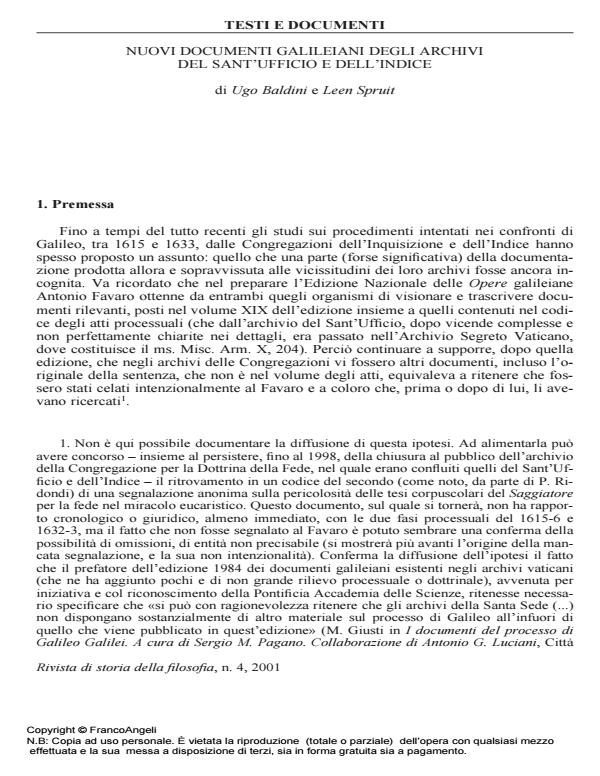Nuovi documenti galileiani degli Archivi del Sant'Ufficio e dell'Indice
Journal title RIVISTA DI STORIA DELLA FILOSOFIA
Author/s Ugo Baldini, Leen Spruit
Publishing Year 2002 Issue 2001/4
Language Italian Pages 39 P. File size 162 KB
DOI
DOI is like a bar code for intellectual property: to have more infomation
click here
Below, you can see the article first page
If you want to buy this article in PDF format, you can do it, following the instructions to buy download credits

FrancoAngeli is member of Publishers International Linking Association, Inc (PILA), a not-for-profit association which run the CrossRef service enabling links to and from online scholarly content.
Studies on the 1616 and 1633 actions brought against Galilei by the Index and the Inquisition generally presumed that (a significant) part of the documentation was still to be unveiled. This assumption was frequently accompanied by the hypothesis that some available documents were forgeries, merely composed to justify the 1633 condemnation. New documents from the Archive of the Roman Inquisition, including a censure of Saggiatore, official acts concerning the public dissemination of the verdict, and applications for permission to read Galilei¹s works, show that the 1984 edition of his trial was not exhaustive. It is argued, however, that these documents were not concealed intentionally by the Holy Office and their not being found so far has been mainly due to the poor organisation of the Archive. Gianfranco Catelli, Gouhier e la cosiddetta dottrina della terza nozione primitiva In questo studio non si condivide l’opinione, dominante per molti decenni, che il cosiddetto dualismo cartesiano sia dovuto ad un “malinteso”, che può chiamarsi originario, dato che a rimanerne coinvolti furono alcuni tra i primi seguaci della filosofia di Cartesio. Una presa di posizione, questa, che, già sviluppata in altri precedenti lavori, viene qui riproposta relativamente a H. Gouhier, lo studioso che più di ogni altro, con ricchezza di documenti e sottigliezza di analisi interpretative, ha sostenuto la tesi del “malinteso” e ha individuato nella dottrina della terza nozione primitiva la spiegazione autenticamente cartesiana del rapporto sussistente tra anima e corpo. Una interpretazione di cui nel presentge studio si mostra tutta la debolezza, soprattutto se la si considera alla luce dell’altra dottrina, anch’essa cartesiana, ma di gran lunga più articolata, che fa del rapporto tra anima e corpo un nesso da spiegarsi in analogia al rapporto che nel linguaggio intercorre tra il segno e il suo significato.
Ugo Baldini, Leen Spruit, Nuovi documenti galileiani degli Archivi del Sant'Ufficio e dell'Indice in "RIVISTA DI STORIA DELLA FILOSOFIA" 4/2001, pp , DOI: